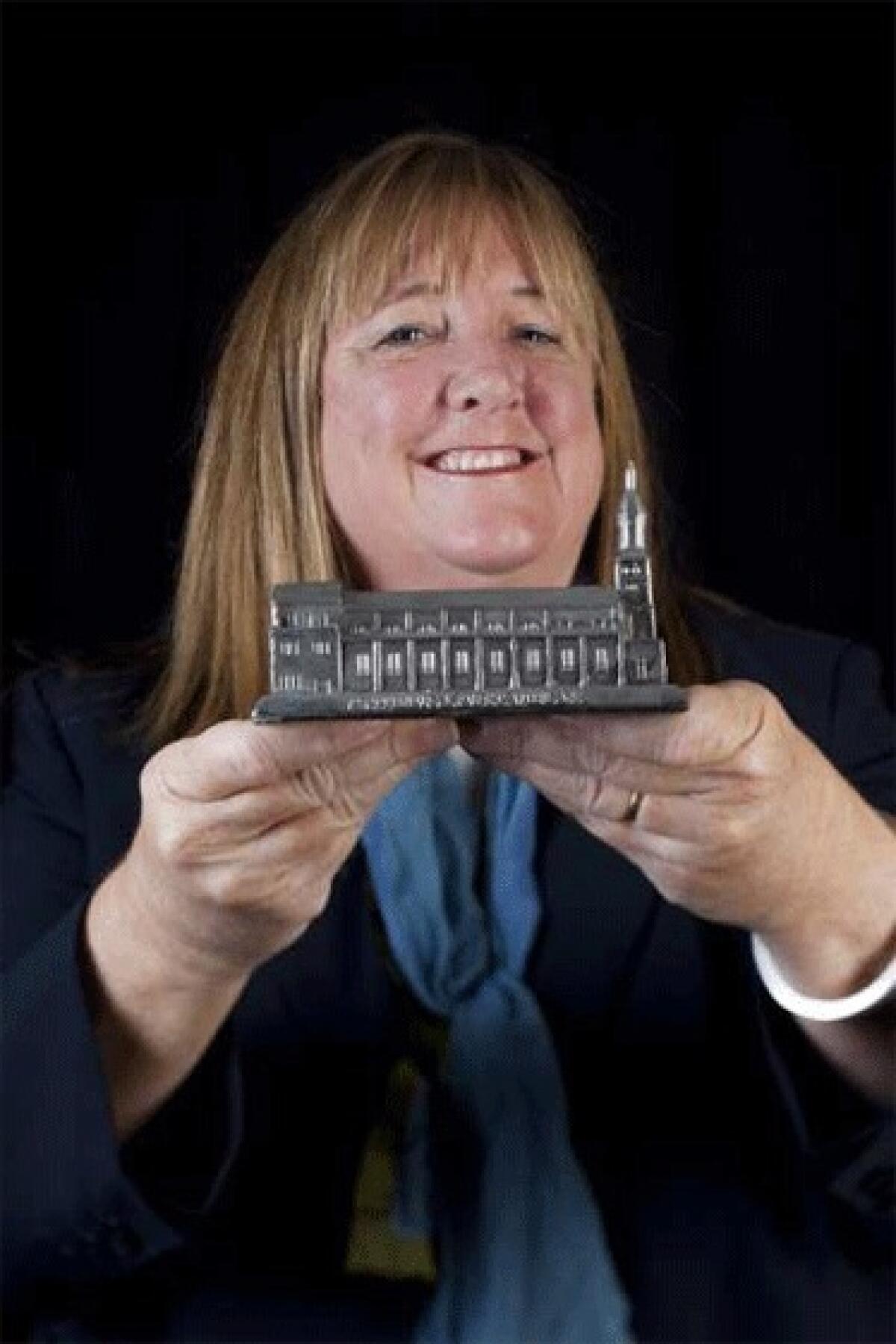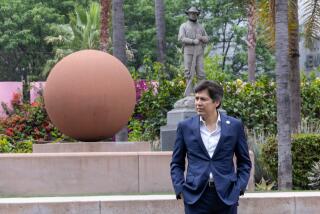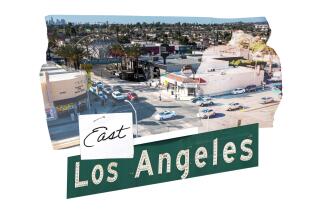Linda Dishman -- preserving L.A., a building at a time

Been to a concert at the Wiltern? Toured downtown’s movie palaces? Love the Central Library? You can thank the Los Angeles Conservancy that they’re still here. And for 20 of the conservancy’s 34 years, Linda Dishman has been its executive director, fighting the wrecking ball and trying to keep historic buildings from being threatened in the first place. The organization’s nearly 7,000 members make it the biggest local preservation group in the country, and proof that Angelenos see plenty worth preserving in what people too often think of as a tear-down city.
You were born in Sacramento, but historic Los Angeles was part of you before you’d ever seen Los Angeles.
My mother grew up in South Pasadena, so I grew up with stories of Los Angeles, the Broadway theaters. She’d take the streetcar; she worked at Bullocks downtown. So I had a familiarity with Los Angeles. It wasn’t until I came here that I got to understand all that Los Angeles is.
Isn’t there still an attitude that L.A. is so new it really doesn’t have much worth preserving?
There’s a stereotype — either we don’t have any history or the people here don’t care about their history.
We didn’t develop as early as San Francisco or Sacramento. We were founded in 1781, and we don’t have a lot of buildings left from this period. Much of our growth occurred after World War II. The preservation we’re doing is very different from other cities.
Is that a harder sell than, say, protecting a structure like the Avila adobe?
It’s a different sell. We did an initiative called “The ‘60s turn 50,” because 50 years is the traditional demarcation of what’s historic. We have three threatened buildings from the ‘60s, and people didn’t understand why these buildings were significant. One was the Century Plaza Hotel. We kept hearing, well, this can’t be historic because I remember when it was built. We did nine months of educational outreach: the ‘60s were when L.A. really became a major city. People began to embrace it.
The Century Plaza was designed by Minoru Yamasaki, who designed the World Trade Center towers. The astronauts had their first [gala] dinner there after they came back from the moon. [For some events,] it was Reagan’s Western White House. And the thousands of weddings and bar mitzvahs — we want to preserve important places because they are important, but we also want the places that have personal meaning.
California has destroyed more than 90% of its wetlands. People seem to start to worry about such things when there’s almost nothing left.
People’s understanding of what’s historic is the difference. It’s easier when something’s really old or it’s the last.
When we were fighting to save the Downey McDonald’s, [people asked], “Why are you saving a hamburger stand”? This was the second McDonald’s and the oldest remaining one. It could tell the story. This place changed the way America ate. This is the McDonald’s that Ray Kroc came to as a traveling milkshake-maker salesman and realized they had a good thing going and he bought into the franchise. This is a truly historic place.
It’s still a hamburger stand, which we’re thrilled about. McDonald’s has restored it. We need to save the best before we’re down to the last.
St. Vibiana was L.A.’s original cathedral, opened in 1876. In 1996, the archdiocese began to raze it without permits. Now it’s an event space. The conservancy saved it.
We’d been meeting with the archdiocese to find a preservation solution. I was in San Jose, and I got a call from an L.A. Times reporter, Larry Gordon, saying the archdiocese was going to begin demolition of the bell tower the next morning because they said it was unsafe. I got a flight out and drove straight to the site from the airport. The cranes were there; lots of media were there. Our lawyer was there. We were able to get a temporary restraining order, which I don’t think anyone thought we could do.
So began what I think of as the summer of St. Vibiana. It was day to day. The city tried to get the state to exempt the property from CEQA, the California Environmental Quality Act. [State] Sen. Tom Hayden was the savior on that. Then the city decided to remove the cathedral’s landmark designation, on a 14-1 vote. We had to go to court again, and we won that one too. When the cardinal [Roger Mahony] threatened to move the [site of the new] cathedral to the Valley, the Board of Supervisors said, “We have a piece of property you might be interested in,” and that’s where the [new] cathedral is now.
There was so much pressure from civic leaders — that we were going to stop the revitalization of downtown; that if we just let this one go, all the other buildings would be saved. I admire our board for holding firm.
What are the lessons from these 4th-and-long situations?
We had been in the habit of saying no, no to demolition. We decided we had to be for something. [Saving St. Vibiana] began a process of saving buildings before they’re threatened, so we’re not always in these do-or-die situations. In 1999 we created the Broadway Initiative, working with developers to help them through the process, to [make] preservation the first choice and an easy choice. We developed great relationships with property owners and developers.
We don’t want buildings to be restored and under glass where they’re treated like an object in a museum. Historical buildings need uses; they need to be part of an active, vibrant community.
What’s been most effective in helping to save buildings is CEQA [signed into law by Gov. Ronald Reagan in 1970]. The preservation movement got more skilled at understanding how to make sure historic preservation is considered like wildlife and water and air.
You hear complaints about CEQA — too much regulation.
There are ways to make CEQA more efficient. I’m not sure it needs to be as time-consuming as it. But the core value of CEQA is something people appreciate.
Has much changed in your 20 years doing this work?
People are becoming more vocal. The Historic Preservation Overlay Zone movement has grown; we now have 29 districts with preservation plans that fit the character of the neighborhood. Changes are reviewed by local residents and experts. This is a movement. This isn’t just the conservancy. That’s one of the great secrets about Los Angeles: People really identify with their neighborhoods.
What do you say to the accusation that preservation is what rich people do?
About the half the buildings that are protected [by a preservation zone] are in lower-middle-class neighborhoods — Lincoln Heights, Pico Union, Highland Park. Yes, they’re [also] in wealthy neighborhoods, but it’s across the economic board.
There are ways to [preserve] that are efficient, and incentives for historical preservation. I don’t think the cost argument is necessarily accurate anymore. We have a track record, particularly on adaptive reuse downtown. We bring experts to the table when we’re fighting to save a building and find a win-win solution.
Much of L.A.’s historic architecture is residential, not grand public buildings. Is that harder to see and to save?
Yes; that doesn’t mean we still aren’t trying. We’ve made tremendous progress with big-name architects like Schindler and Neutra. It’s the lesser-known architects that we lose.
We get lots of phone calls: People drive by [an historic house] and see something [suspicious]. There’s no preservation police. We really are dependent on people out and about who care.
You have victories like St. Vibiana, the Wiltern, the Cinerama Dome, and losses, like the Ambassador Hotel, torn down for a school. Neither the Cocoanut Grove nor the pantry where Robert F. Kennedy was assassinated were saved.
Sometimes you just lose. [The school district] wanted to replicate [the Cocoanut Grove]. Replication is like going to Disneyland: Do you teach what real Main Streets are like by going to Main Street Disneyland? That’s not the right message. We felt it could be a great educational facility. Students read “The Great Gatsby” — Scott Fitzgerald stayed at that hotel. Few places have those links that would really have excited kids. Ultimately we didn’t prevail, and we’ve moved on.
I’m a believer in blue-plaque historical markers, like the ones in London. Can we do that in L.A.?
We’re looking into doing that with smartphones!
What’s your house like?
It’s a 1948 Silver Lake traditional. It’s just a nice little house that’s not going to be an individual landmark.
Follow Patt Morrison on Twitter @pattmlatimes
This interview was edited and excerpted from a taped transcript. An archive of Morrison’s interviews can be found at latimes.com/pattasks.
More to Read
A cure for the common opinion
Get thought-provoking perspectives with our weekly newsletter.
You may occasionally receive promotional content from the Los Angeles Times.











